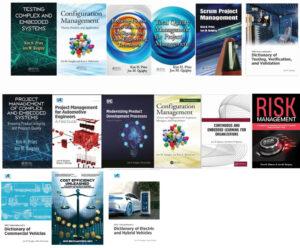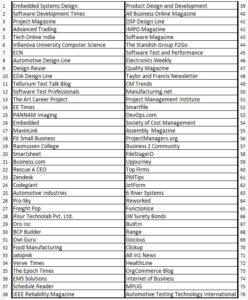Next-Gen Vehicle Architecture: Verification, Validation, and Configuration Management
By: Jon M. Quigley
Modern automotive engineering hinges on a meticulously managed Vehicle Development Lifecycle, integrating advanced verification, validation, and configuration management to meet safety, performance, and compliance demands. This blog post explores how these pillars ensure robust vehicle architecture while aligning with industry trends like software-defined vehicles and autonomous driving. We have spent many years learning and product development. This is the reason for my multiple master’s degrees on top of my engineering degree, in an attempt to understand the entire product development pipeline (as much as one person can) from the customer’s voice to deliver the project’s scope on time, with cost and quality targets.
The Vehicle Development Lifecycle Framework
The Vehicle Development Lifecycle has evolved beyond traditional waterfall models, leveraging digital twins, AI-driven simulations, and continuous validation to address complex software-hardware interactions. [1] [2] Many metaphorical moving parts (and sometimes literal) exist. The name of the development methodology does not matter; we will need ways to graphically represent the complexity to improve understanding and the ability to analyze the system(s) under development. Key phases include:
- Requirements analysis: Defining functional safety (ISO 26262) and performance targets
- Model-based design: Simulating systems like ADAS and zonal E/E architectures
- Verification: Early defect detection via virtual prototyping (30% faster than physical tests) [3]
- Validation: Real-world scenario testing using hardware-in-the-loop (HiL) systems [1]
Verification: Building Safety into Automotive Software
Verification ensures designs meet specifications before prototyping, reducing costly late-stage revisions. Models are helpful but useless unless we compare the theoretical to the actual environment. We discussed this with an SAE colleague; the connection between the model and the real world is poorly explored. Models represent how we believe internal and environmental variables interact to produce visible performances. Contrived verification (tests) and design of experiments (D0E) are approaches to define the level of veracity of fidelity of the model to actual. Modern approaches include:
- Digital twin integration: Siemens’ tools enable engineers to simulate 10,000+ driving scenarios, from extreme weather to sensor failures[1]
- V-Model enhancements: Continuous verification processes cut development timelines by 40% compared to traditional methods.[4]
- Static code analysis: Identifying security vulnerabilities in AUTOSAR-compliant ECUs[5]
Validation: Proving Real-World Reliability
Validation confirms systems operate safely under diverse conditions. To do this, we will need to develop methods of exploring the systems in the application, the early stages will be with . Automotive leaders now deploy:
| Method | Application | Impact |
| Driver-in-the-Loop (DiL) | Ford’s Mach-E steering feel tuning | 50% fewer physical prototypes [6] |
| OTA validation | Tesla’s shadow mode testing | 95% software update reliability [1] |
| AI-powered test automation | Bosch’s ADAS scenario generation | 10x test coverage improvement [3] |
Configuration Management: Orchestrating Complexity
Vehicles are comprised of many systems that must interact predictably. Configuration management makes traceability from past to future possible, and we can repeatably make a known iteration of the product. With vehicles containing 150+ ECUs, configuration management ensures compatibility across:
- Hardware variants: Geely’s CMA platform supports 9 vehicle models via parameterized builds
- Software versions: Over-the-air updates requiring dependency checks (e.g., brake-by-wire ↔ ABS interactions) [7]
- Compliance tracking: Automated documentation for UN R155 cybersecurity regulations
Key strategies include:
- Hierarchical version control for multi-supplier environments
- Blockchain-backed BOMs ensure component traceability
- Dynamic reconfiguration enabling feature activation post-sale
Industry Trends Reshaping the Vehicle Development Lifecycle
Modern tools are there to help us cover more ground and faster.
- AI-driven validation: GM’s virtual proving grounds simulate 10M+ miles daily [8] [9]
- Adaptive V-Models: Combining agile sprints with safety-critical verification [4]
- Edge case prioritization: Focusing 70% of autonomous vehicle testing on <0.1% probability scenarios [3]
For more information, contact us:
Follow us on social media at:
Amazon Author Central https://www.amazon.com/-/e/B002A56N5E
Follow us on LinkedIn: https://www.linkedin.com/in/jonmquigley/
https://www.linkedin.com/company/value-transformation-llc
Bibliography
| [1] | S. Andrews, “Powering software-defined vehicle insights through verification and validation,” 18 April 2024. [Online]. Available: https://blogs.sw.siemens.com/en-US/automotive-transportation/2024/04/18/powering-software-defined-vehicle-insights-through-verification-and-validation/. |
| [2] | “Applying the V-Model in Automotive Software Development,” 25 June 2021. [Online]. Available: https://www.einfochips.com/blog/v-model-in-automotive-software-development/. |
| [3] | S. Pruisken, “Testing and validation of ECU functions: The road to autonomous driving,” 30 January 2025. [Online]. Available: https://www.elektrobit.com/blog/test-validation-ecu-autonomous-driving/. |
| [4] | S. Thomas, “Applying the V-Model in Automotive Software Development,” einfochips, 24 April 2024. [Online]. Available: https://www.einfochips.com/blog/v-model-in-automotive-software-development/. [Accessed 30 January 2025]. |
| [5] | J. M. Quigley, “Dictionary of Testing, Verification and Validation,” SAE Publishing, Warrendale, PA, 2024. |
| [6] | D. W. Graupner, “Development and Validation in the Automotive Industry – Bridging the Growing Gap.,” 5 September 2020. [Online]. Available: https://www.linkedin.com/pulse/development-validation-automotive-managing-gap-wilhelm-graupner/. [Accessed 30 January 2025]. |
| [7] | C. Heinisch, V. Feil and M. Simons, “Efficient configuration management of automotive software,” in 2nd Embedded Real Time Software Congress (ERTS’04), Toulouse, France., 2024. |
| [8] | J. Howarth, “10 Important Auto Industry Trends (2024-2026),” Exploding Topics, 27 May 2024. [Online]. Available: https://explodingtopics.com/blog/auto-industry-trends. [Accessed 30 January 2025]. |
| [9] | K. H. a. Q. J. M. Pries, Testing Complex and Embedded Systems, Boca Raton, FL: CRC Press, Taylor & Francis Group, 2011. |
| [10] | J. M. Quigley and K. L. Robertson, Configuration Management: Theory and Application for Engineers, Managers, and Practitioners, Boca Raton, FL: CRC Press, 2020. |


